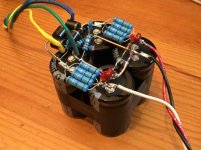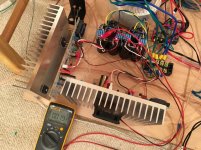Thanks for the plot - pretty much follows the same trend in the rise of THD and H3 on my speaker data.
I am not so sure I can live with this signature as I am very sensitive to distortion, especially 3rd harmonic.
now I am very eager to hear your comment when you hear the amp for a longer time!
Maybe your hear it really!
Let ears decide, now that you got the hint by the curves where to search with your ears, you have a nice task!
now I am very eager to hear your comment when you hear the amp for a longer time!
Maybe your hear it really!
Let ears decide, now that you got the hint by the curves where to search with your ears, you have a nice task!

I plan to leave it in for at least 2 weeks to give it a fair amount of air time. It's better with some genre's than others. On jazz piano, to me, I hear the distortion quite prominently - pitch changing distortion almost like there is a slight discord amongst the keys struck. But on female vocals, it sounds good. The simplicity is indeed inspiring and I like how the auto-bias works so well. I will be upgrading the PSU with qnty 4 x 33mF caps in a couple days so we will see if that helps any. I doubt that will change the harmonic profile though.
now I am very eager to hear your comment when you hear the amp for a longer time!
Maybe your hear it really!
Let ears decide, now that you got the hint by the curves where to search with your ears, you have a nice task!

I am afraid I take a different point of view. Since xrk did not comment on the sound quality before posting the measurements and, in particular, did not mention that he thought he heard "pitch changing distortion" I will be hard-pressed to believe future comments since we have now introduced expectation bias into the situation: does he truly hear the distortion, or does he now believe he hears it since the measurement says it is there?
Last edited:
I listened to it for couple days before making the measurement and what I heard was something was off on pianos - a very tough instrument to recreate well. It did not sound to me like a transparent clean sound that blew me away. So I was expecting to see something show up in the measurements. I did not mention it first but doesn't mean I didn't hear it. Indeed, my ears hear distortion quite well - I scored -45dB on the Klippel audibility of distortion test. Well below the nominal median -21dB level.
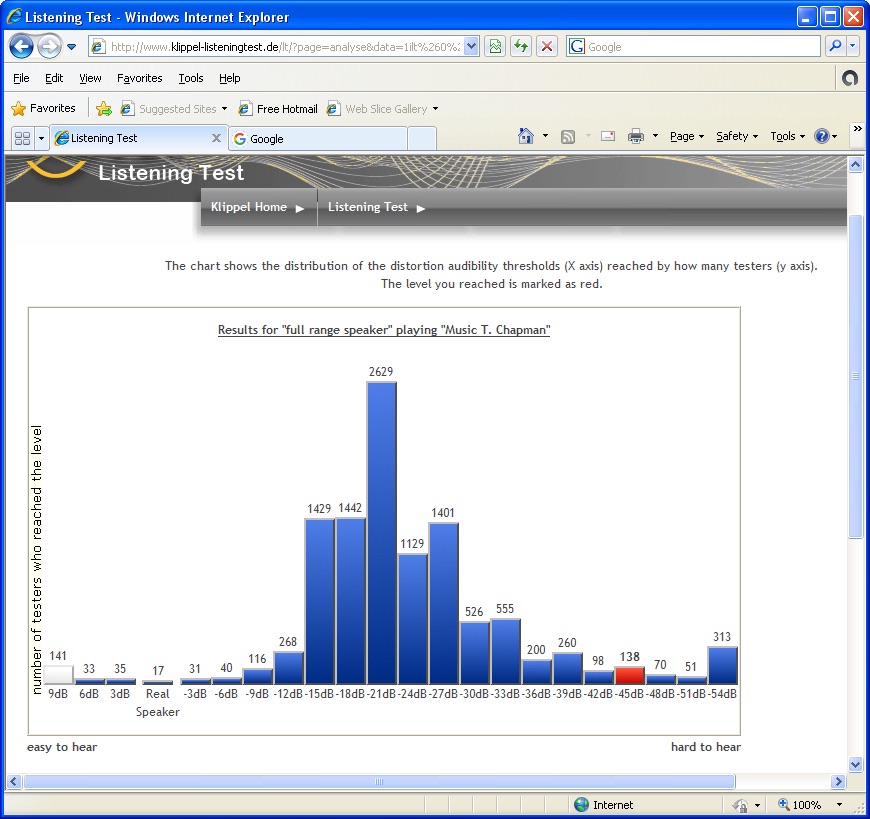
@ZM:
I agree, that it is.

@ZM:
M2 is Music Machine
I agree, that it is.
I have a hard time swallowing anyone hearing the differences in the posted measurements based on k3 below 100hz. Above 100 the amps measurements were not that different and the k3 was actually lower on the m2 in a few spots. The character of the amplifiers will always be different because of circuit designs. As ZM said, it makes music.
Hi xrk,
I don't understand the graphs you posted, they are showing dB in the y-axis. To what do they relate? And which power did you set the amp to while measuring, in which load?
Thanks for the explanation
Matthias
PS:
Pianos also had always been the instruments for me that made me like or hate an amp (pre/power, dac, whatsoever).
I don't understand the graphs you posted, they are showing dB in the y-axis. To what do they relate? And which power did you set the amp to while measuring, in which load?
Thanks for the explanation
Matthias
PS:
Pianos also had always been the instruments for me that made me like or hate an amp (pre/power, dac, whatsoever).
Last edited:
Hi xrk,
I don't understand the graphs you posted, they are showing dB in the y-axis. To what do they relate? And which power did you set the amp to while measuring, in which load?
Thanks for the explanation
Matthias
Those are *microphone* measurements of my reference speakers which I know how they sound and how they measure with other amps. The M2 has an elevated HD bulge that was not present with my other amps (mostly class AB amps).
I don't have an amplifier measurement setup yet, so all I can do is measure what the amp does to my speaker ouput.
More details of the speaker can be found here:
http://www.diyaudio.com/forums/full...-rs225-8-fast-ref-monitor-68.html#post4743530
Details of my amplifier comparison thread is here (you can listen to sound clips where different amps are tested in same setup):
http://www.diyaudio.com/forums/solid-state/295286-virtual-audition-very-simple-quasi-mosfet-amp.html
Hope that helps.
I have a hard time swallowing anyone hearing the differences in the posted measurements based on k3 below 100hz. Above 100 the amps measurements were not that different and the k3 was actually lower on the m2 in a few spots. The character of the amplifiers will always be different because of circuit designs. As ZM said, it makes music.
Listen for yourself - here are precision collected sound clips where speaker and microphone, source etc are the same. With only difference being the amp.
For example, the FX8 Bimo mod amp:
http://www.diyaudio.com/forums/soli...very-simple-quasi-mosfet-amp.html#post4797062
versus, the M2:
http://www.diyaudio.com/forums/soli...y-simple-quasi-mosfet-amp-16.html#post4816660
You need to change the sound clip files from .asc to .mp3 to listen.
The process for recording and setup used is described here:
http://www.diyaudio.com/forums/solid-state/295286-virtual-audition-very-simple-quasi-mosfet-amp.html
I do want to say that the M2 is a very nice sounding amplifier, so don't get me wrong - it just has some artifacts that I can hear when playing certain genre's.
Last edited:
Hi xrk971,
my question didn't had a subtest, so don't feel offended, please. We are here to habe fun. And also, it would be really pity if someone can't say his opinion about something, when it's contrary to the crowd belief!
When I started to do measurements, I first thought I've done a good job. But then comes the understanding, which should be there in the first place.
Or, what we say in German: "Wer viel misst, misst Mist!" (Who's measuring a lot, just get dung funny numbers. [There seems to be some auto correction, so I chose the biological translation.] ).
).
Matthias
my question didn't had a subtest, so don't feel offended, please. We are here to habe fun. And also, it would be really pity if someone can't say his opinion about something, when it's contrary to the crowd belief!
When I started to do measurements, I first thought I've done a good job. But then comes the understanding, which should be there in the first place.
Or, what we say in German: "Wer viel misst, misst Mist!" (Who's measuring a lot, just get dung funny numbers. [There seems to be some auto correction, so I chose the biological translation.]
Matthias
Ah, and when I set-up Arta the first time, I followed the manual exactly. Having a ESI Juli@ soundcard, which has some quite good numbers, I just set the 0dBfs point to the maximum, which is stated in the technical manuel of the soundcard. But of cause it is not the voltage input reagion with the lowest distortion, but this I learned just a bit later.
I now know, that even when I'm excited like a boy waiting for christmas, I have to do my homework, and this is first to measure the measuring device to know its strengths and weaknesses. And now I get better measurements, and also my graphs are set-up (normalized) like it should be.
But as you said, you can compare your measurement to other measurements, it is also ok, as you just changed one part at a time.
Would be interesting to see, if you get the same graphs, when you use a dummy load (say a 8 Ohm resistor) for different amplifiers. Someone in the other thread, where you posted, stated, that for good sound you need the correct match between amp and speaker. Or to look at it from a different view, perhaps the amp without global feedback didn't like the load of your specific speaker, and the other amp don't has this problems.
I would be really curious!
Ah, do you get comparable figures like shown in the graphs and listed on the last page in the manual here: http://www.firstwatt.com/pdf/prod_m2_man.pdf ?
The input transformer is known to catch all sorts of electromagnetic radiation. If you run your THD measurements, just try to shield it and see if it changes. If you do so, then try to slowly rotate your transformator. It sometimes has a big impact, also if a transformer as gaining device is absent in a circuit.
If you get chaning distortion numers, I would be really curious, if the piano also sounds different!
Regards,
Matthias
I now know, that even when I'm excited like a boy waiting for christmas, I have to do my homework, and this is first to measure the measuring device to know its strengths and weaknesses. And now I get better measurements, and also my graphs are set-up (normalized) like it should be.
But as you said, you can compare your measurement to other measurements, it is also ok, as you just changed one part at a time.
Would be interesting to see, if you get the same graphs, when you use a dummy load (say a 8 Ohm resistor) for different amplifiers. Someone in the other thread, where you posted, stated, that for good sound you need the correct match between amp and speaker. Or to look at it from a different view, perhaps the amp without global feedback didn't like the load of your specific speaker, and the other amp don't has this problems.
I would be really curious!
Ah, do you get comparable figures like shown in the graphs and listed on the last page in the manual here: http://www.firstwatt.com/pdf/prod_m2_man.pdf ?
The input transformer is known to catch all sorts of electromagnetic radiation. If you run your THD measurements, just try to shield it and see if it changes. If you do so, then try to slowly rotate your transformator. It sometimes has a big impact, also if a transformer as gaining device is absent in a circuit.
If you get chaning distortion numers, I would be really curious, if the piano also sounds different!
Regards,
Matthias
Murdoc,
To be clear, my measurements are of the sound coming from the speaker so it is with a mic. I can't measure the distortion of the amp on a dummy load (yet). That takes a high quality ADC with low noise.
But if I can pick up new distortion that was not there before at the speaker as sound waves, there must be something quite significant going on with the amp. The results I have are consistent with observations by another member and with the M2 manual written by Mr Pass where he says dominant distortion is 3rd harmonic. There is even a graph showing input sine wave and output with 3x frequency. It's pretty well accepted that second harmonic is less objectionable than 3rd or 5th as they are perceived psychoacoustically as discord rather than harmony.
To be clear, my measurements are of the sound coming from the speaker so it is with a mic. I can't measure the distortion of the amp on a dummy load (yet). That takes a high quality ADC with low noise.
But if I can pick up new distortion that was not there before at the speaker as sound waves, there must be something quite significant going on with the amp. The results I have are consistent with observations by another member and with the M2 manual written by Mr Pass where he says dominant distortion is 3rd harmonic. There is even a graph showing input sine wave and output with 3x frequency. It's pretty well accepted that second harmonic is less objectionable than 3rd or 5th as they are perceived psychoacoustically as discord rather than harmony.
Tea-bag, has some experience with different transformers in the F6 clone build.
He has posted several comments on the forum comparing Cinemag, Jensen, and O-netics, I believe. The thread was 'convertible F6' or something like that.
New PSU with lots of caps
I built the recommended qnty 4 x 33,000uF CRC PSU with qnty 4 x 0.47R per rail. I added a 330pF & 10R snubber to clamp the diode switch noise and 100nF 100V MKT bypass caps on the outputs. The DC power ripple with full class A operation is measured at 19mV. The nominal 25v rails sag to about 23.5v when running.
The extra caps seems to have improved the sound stage width and imaging. The overall dynamics are very good and I am actually starting to enjoy the sound on a lot of material. Listening to Gretchen Parlato and Melody Gardot. Also throwing in some Paul Moatian. Good stuff.
Here is a closeup of one of the new PSU's made with P2P for super compact footprint:
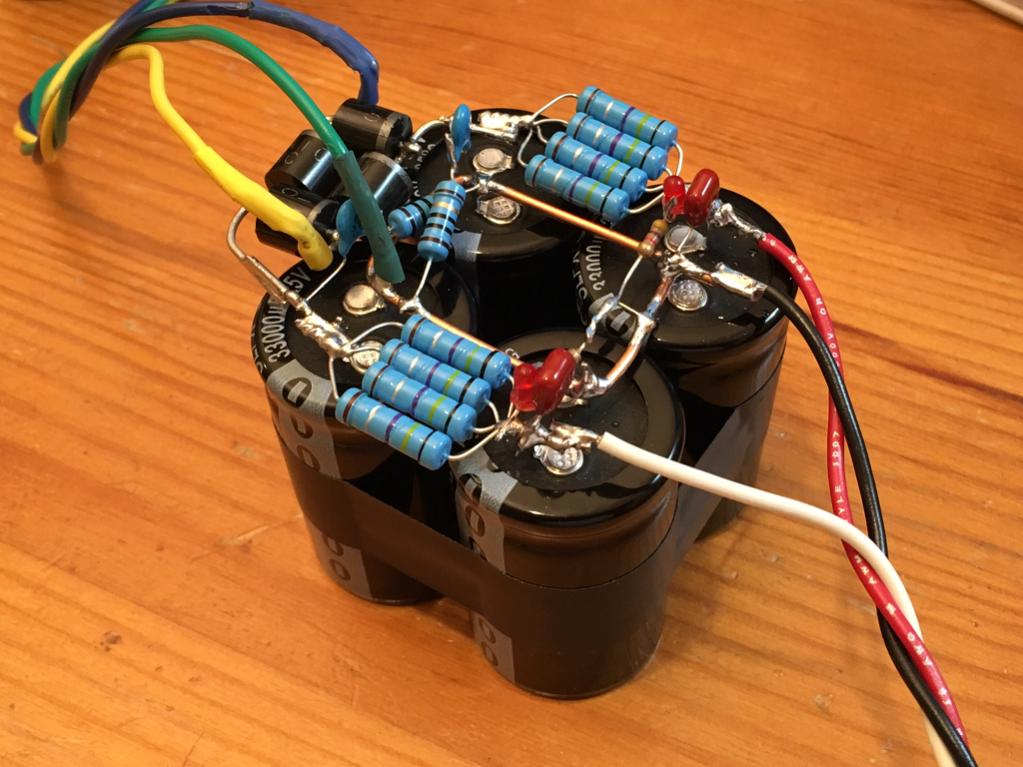
Here is the measurement of the ripple with DMM:
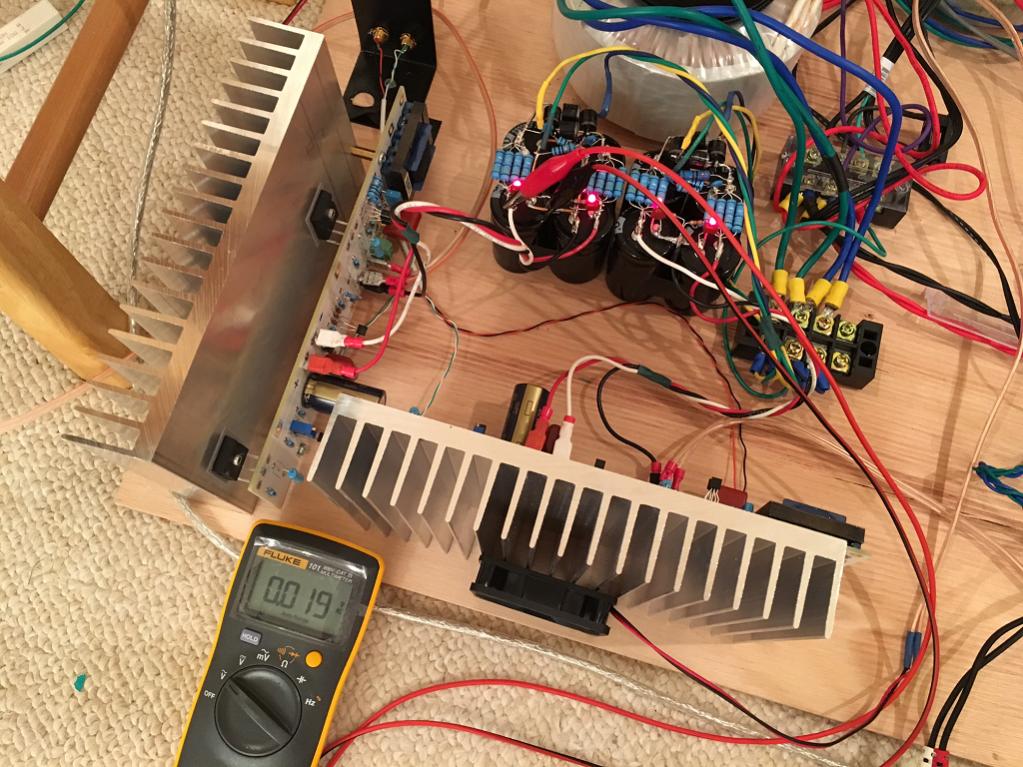
Here is the rearview of the amps:
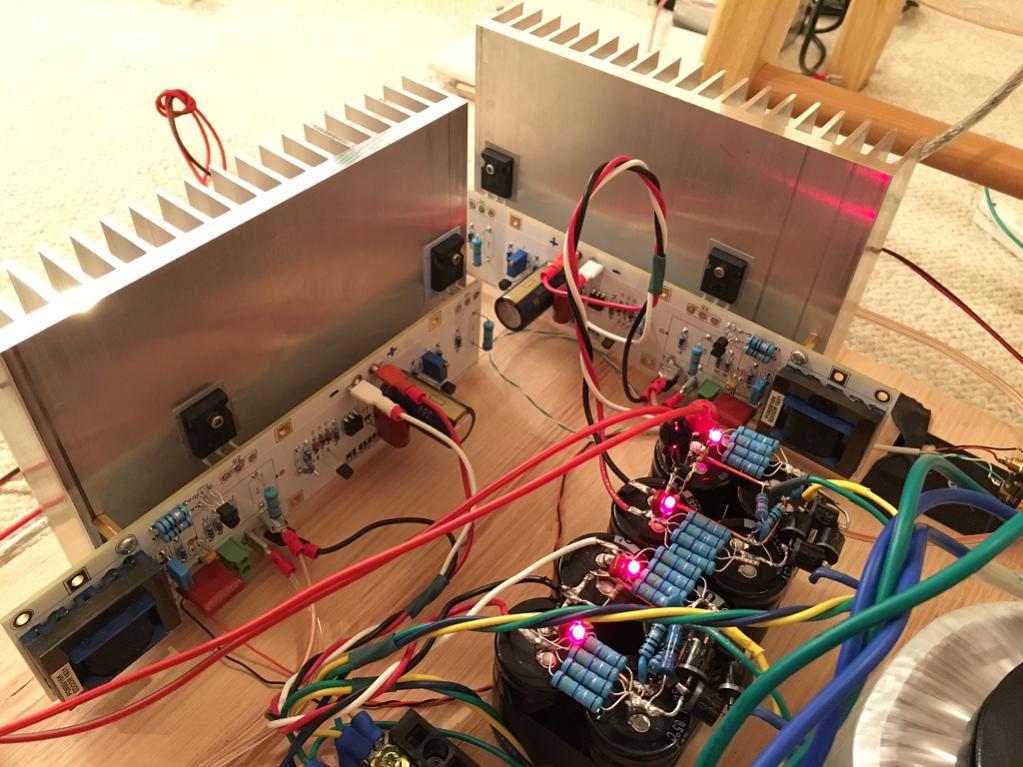
I re-measured the frequency response of the speakers and distortion. It looks the same as before, maybe even a bit more HD in the bass this time since I am skipping my 40,000uF low ESR cap bank with LC filter. I think that makes a difference with distortion actually.
I built the recommended qnty 4 x 33,000uF CRC PSU with qnty 4 x 0.47R per rail. I added a 330pF & 10R snubber to clamp the diode switch noise and 100nF 100V MKT bypass caps on the outputs. The DC power ripple with full class A operation is measured at 19mV. The nominal 25v rails sag to about 23.5v when running.
The extra caps seems to have improved the sound stage width and imaging. The overall dynamics are very good and I am actually starting to enjoy the sound on a lot of material. Listening to Gretchen Parlato and Melody Gardot. Also throwing in some Paul Moatian. Good stuff.
Here is a closeup of one of the new PSU's made with P2P for super compact footprint:

Here is the measurement of the ripple with DMM:

Here is the rearview of the amps:

I re-measured the frequency response of the speakers and distortion. It looks the same as before, maybe even a bit more HD in the bass this time since I am skipping my 40,000uF low ESR cap bank with LC filter. I think that makes a difference with distortion actually.
Attachments
My kind of PS board. I do install them on a small wood board with hot glue and then install the board in the case. And do cover them with a magazine when you are working inside the amp. Drop a screwdriver on them caps and you will get a wake up call. When the amp is finished and the cover is on it will not matter which side of the caps are up. I expect you already know all this but for those that don't.
I see no sense paying for a board when all it does is hold the caps and a couple of resistors but then I am a cheap diy'er.
I see no sense paying for a board when all it does is hold the caps and a couple of resistors but then I am a cheap diy'er.
Last edited:
- Home
- Amplifiers
- Pass Labs
- Official M2 schematic
